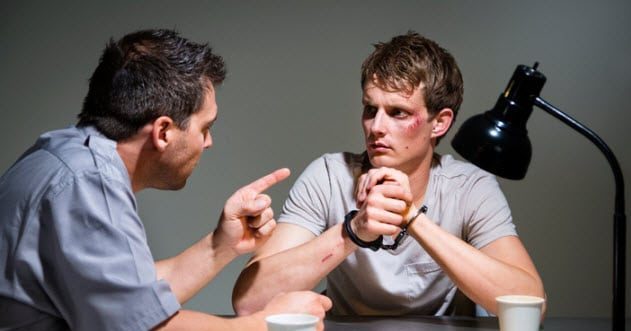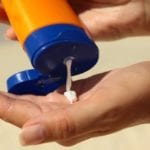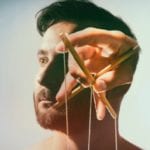 Mysteries
Mysteries  Mysteries
Mysteries  History
History 10 Surprising Stories About the Texas Rangers
 Humans
Humans 10 Philosophers Who Were Driven Mad by Their Own Theories
 Miscellaneous
Miscellaneous 10 Video-Game-Worthy Weapons and Armors from History
 Weird Stuff
Weird Stuff 10 Psychics Who Accurately Predicted Wartime Events
 The Arts
The Arts 10 Pieces of Art Inspired by a Broken Heart
 Health
Health 10 Science Fiction-Sounding New Medical Treatments
 History
History 10 Surprising Facts About the Father of Submarine Warfare
 Space
Space Ten Astonishing New Insights into Alien Worlds
 Weird Stuff
Weird Stuff 10 Bizarre Summer Solstice Rituals Still Practiced Today
 Mysteries
Mysteries Top 10 Haunting Facts About the Ghost Ship MV Alta
 History
History 10 Surprising Stories About the Texas Rangers
 Humans
Humans 10 Philosophers Who Were Driven Mad by Their Own Theories
Who's Behind Listverse?

Jamie Frater
Head Editor
Jamie founded Listverse due to an insatiable desire to share fascinating, obscure, and bizarre facts. He has been a guest speaker on numerous national radio and television stations and is a five time published author.
More About Us Miscellaneous
Miscellaneous 10 Video-Game-Worthy Weapons and Armors from History
 Weird Stuff
Weird Stuff 10 Psychics Who Accurately Predicted Wartime Events
 The Arts
The Arts 10 Pieces of Art Inspired by a Broken Heart
 Health
Health 10 Science Fiction-Sounding New Medical Treatments
 History
History 10 Surprising Facts About the Father of Submarine Warfare
 Space
Space Ten Astonishing New Insights into Alien Worlds
 Weird Stuff
Weird Stuff 10 Bizarre Summer Solstice Rituals Still Practiced Today
10 Women Whose Work You Know But Not Their Names
No surprise that women were the brains behind the invention of many useful household items ranging from the dishwasher (Josephine Garis Cochran, 1893) to the foot-pedal trash can (Lillian Moller Gilbreth, best known as the mother in Cheaper by the Dozen) and an early version of the disposable diaper (Marion Donovan, 1950s).
But from the very birth of the United States, women have made countless, little-known contributions, both major and mundane, that continue to aid us, entertain us, enrich our national heritage, improve our wellbeing, and save lives. Here are ten women whose contributions you know even if their names remain unknown.
Related: 10 Life-Changing Inventions That Were Discovered By Accident
10 The Declaration of Independence
No, Thomas Jefferson had no woman at his elbow as he penned those immortal words. By mid-July of 1776, the text of the Declaration of Independence appeared in newspapers throughout the colonies. However, it was not until the following January, after George Washington had crossed the Delaware on Christmas Day and beaten the British at Trenton, did the Continental Congress dare to distribute the first edition that identified the rebels who had signed it. So they set about printing official copies for distribution. And below the names of John Hancock, John Adams, Josiah Bartlett, and other traitors to the Crown, King George III could read the bold statement: “Baltimore, in Maryland: Printed by Mary Katharine Goddard.”
Following her experience publishing the Providence Gazette in Rhode Island and the Pennsylvania Chronicle in Philadelphia, Goddard (1738-1816) took over the Maryland Journal in 1774. During the run-up to the American Revolution, she reported on its early battles, reprinted Thomas Paine’s pamphlet Common Sense, and encouraged women to boycott British goods. She became postmaster of Baltimore in October 1775 and held that job until 1789, which may have made her the new nation’s first female employee.[1]
9 Paper Bags
An advance does not have to change history to affect how people go about their daily lives. If you have ever been offered “paper or plastic?” and chosen the former, you have Margaret E. Knight (1838-1914) to thank. After losing her father at age twelve, she went to work in a Manchester, New Hampshire, textile mill. Within a year, she had devised a system to keep loom shuttles from flying off and injuring weavers. After holding various other jobs, she moved on to the Columbia Paper Bag company, where flat-bottom paper bags were a specialty item made by hand. To automate this process, she built a machine that could feed, cut, and fold the paper and then form the squared bottom of the bag.
Having made no money from her earlier improvement to the loom, this time Knight took the rare step—for a woman—of applying for a patent. And when a man who had seen her machine during development tried to claim the invention as his own, she fought back. In response to his argument that no woman could have possibly designed such a thing, she produced detailed blueprints, while he offered nothing in his defense. She won the case and received her patent in 1871. Knight went on to found the Eastern Paper Bag Company in Hartford, Connecticut, and receive patents for at least twenty-six more inventions.[2]
8 “America the Beautiful”
Katharine Lee Bates (1858-1929) was an English instructor at Wellesley, her alma mater near Boston, when she took a cross-country train to Colorado Springs for a three-week teaching assignment in the summer of 1893. Along the way, she visited the World’s Columbian Exposition in Chicago, whose famous White City fairgrounds she would later refer to as “alabaster cities.” While out West, she and other professors took a wagon to the top of Pike’s Peak. As she would later write, “It was then and there, as I was looking out over the seas-like expanse of fertile country spreading away so far under those ample skies, that the opening lines of the hymn floated into my mind.”
Her completed poem titled “Pike’s Peak” appeared in the weekly newspaper The Congregationalist on July 4, 1895. A small check for its publication was the only payment Bates ever received, even though her words were set to music repeatedly. While few people may live in Bates Dorm on the Wellesley campus or visit the Colorado Springs Pioneers Museum where her bronze statue sits facing Pike’s Peak, we all know the first verse of her song.[3]
7 Medical Syringe

In recent years, we have become all too familiar with shots in arms. In its simplest form, a syringe is a pump consisting of a plunger that fits tightly into a cylindrical tube. The plunger can be pulled and pushed along inside the tube, allowing the syringe to pull in or push out a liquid or gas through the opening at the end of the tube. That open end may also be fitted with a hypodermic needle, a nozzle, or tubing to help direct the flow into and out of the tube.
While not what we use today, syringes themselves date back to the Greeks and Romans. They weren’t used to inject medication but rather to anoint the skin with ointments and creams. They are mentioned in a journal called De Medicina for use to treat medical complications. Then, in the 9th century AD, an Egyptian surgeon created a syringe using a hollow glass tube and suction. However, it wasn’t until the 19th century that they took on their more familiar form using the hypodermic needle.
Early designs for a syringe with a hollow needle fine enough to pierce skin have been around since 1844, but those contraptions, operated by either a plunger or a screw, were large and required the use of two hands. A New York nurse, Letitia Mumford Geer (1852-1935), helped revolutionize healthcare with her 1899 patent of a compact syringe that could be operated with one hand, making it easier for a medical professional or even a patient to use. While little is known of her life, other than she died in Kings County, New York, the basic design of her brainchild lives on.[4]
6 Monopoly
In 1904, while working as a secretary, Elizabeth “Lizzie” J. Magie (1866-1948) secured a patent for what she called The Landlord’s Game. According to its detailed rules, players rolled dice to land on spaces with different costs for rent and purchase, as well as Water Franchise, Light Franchise, four railroads, and Public Parking. Each time they passed the square labeled “Labor Upon Mother Earth Produces Wages,” they collected $100. Sound familiar?
Her 1924 patent for a revised edition, which featured properties of increasing values with names such as Lonely Lane, Rickety Row, Progress Park, and Easy Street, included a statement that the game was intended not simply for amusement but also to show players the unfair financial advantages of greedy landlords.
Magie’s game had circulated in various forms for a decade by the time Charles Darrow played on a board featuring the names of Atlantic City properties. In 1935, Darrow sold his version to the Parker Brothers company, falsely claiming, “being unemployed at the time, and badly needing anything to occupy my time, I made by hand a very crude game for the sole purpose of amusing myself.”
More than two million copies flew off the shelves in the first two years, and Darrow made a fortune in royalties. Also, in 1935, Lizzie Magie Phillips, by then married to a successful businessman, sold her patent to Parker Brothers for a flat $500 in the hope of reaching a wider audience with her warning about economic inequality. Instead, Monopoly went on to teach generations of children that greed is good. However, in a twist of fate, Magie Phillips’ role and her viewpoint were revived in the 1970s during a trademark legal case over another game: Anti-Monopoly.[1]
5 Kevlar
While this superplastic may be best known for its most dramatic use, the bullet-proof vest, Stephanie L. Kwolek (1923-2014) discovered Kevlar in the course of research seeking a new lightweight material to use in tires to make cars more fuel efficient. She was born in New Kensington, Pennsylvania, where she picked up a love of fabrics and sewing from her mother and a love of science from her father. In 1946, she graduated from Margaret Morrison Carnegie College with a degree in chemistry. To earn money for medical school, she took a job as a chemist in a DuPont research lab, where she went on to spend her entire career.
In the course of Kwolek’s experiments in 1965, she created a cloudy solution that, when spun, made a heat-resistant fiber that was lightweight yet five times stronger than steel. Today, Kevlar is used in products ranging from helmets to brake pads in addition to body armor. Though she was recognized with multiple awards and inducted into the National Inventors Hall of Fame, the would-be doctor once said of her discovery, “I don’t think there’s anything like saving someone’s life to bring you satisfaction and happiness.”[6]
4 3D Movies
If you have ever jumped in your theater seat because an object looked to be coming at your head, credit Valerie Thomas (1943– ). Though not encouraged to study science as a child, she earned a degree from Morgan State University as one of only two women in her class to major in physics. After graduation, she took a job at NASA as a data analyst/mathematician, remaining there until her retirement in 1995.
In addition to her work on the Landsat program, which captures images of Earth from space, she invented an “illusion transmitter.” This transmitter uses two curved mirrors and a camera to reflect an image to the eye at two different angles that combine in the brain to create the illusion of three dimensions. While not the first 3D technique, Thomas received a patent in 1980 for an invention unique in its simplicity.[7]
3 Vietnam Veterans Memorial
When “The Wall,” as it is frequently called, was dedicated in 1982 in Washington, DC, its design was controversial, like the war whose veterans it honored. A panel of eight artists and designers considered more than 1,400 anonymous submissions. They ultimately chose the work of Maya Lin (1959– ), who turned out to be a 21-year-old undergraduate architecture student at Yale who had created her design as a class project.
Lin was born in Ohio to parents who had fled mainland China. Her simple yet powerful design for a V-shaped wall now inscribed with more than 58,000 names only earned her a B on her assignment. However, she did beat out her professor in the competition.[8]
2 Laser Photoablative Cataract Surgery
This medical mouthful is not exactly a household term, even under its more common name, the Laserphaco Probe. But quite likely, someone you know is able to read these words because of it. Patricia Era Bath (1942-2019), a graduate of Howard Medical School, had already racked up an impressive list of accomplishments and “firsts” when she became the first female African American doctor to receive a medical patent in 1988.
Her device, using laser technology to break up and remove cataracts that cloud vision with age, is faster, easier, and less invasive than earlier techniques. In 2014, her invention was recognized by the U.S. Patent and Trademark Office as “one of the most important developments in the field of ophthalmology” for having “helped restore or improve vision to millions of patients worldwide.”[9]
1 Voice over Internet Protocol (VoIP)
Marian R. Croak (1955-) earned a Ph.D. from the University of Southern California in 1982 and went straight to a job at AT&T’s Bell Laboratory. During the 1990s, her groundbreaking work changed the way we communicate, as she received more than one hundred patents related to Voice over Internet Protocol (VoIP) technologies.
This is the electronic magic that supports video chat and has allowed millions to perform tasks as diverse as casting a vote for American Idol or donating to a charity via text. She is a member of the National Inventors Hall of Fame class of 2022, joining the late Dr. Bath as only the second Black woman to be so honored.[10]








